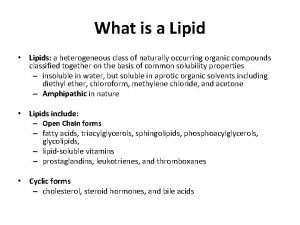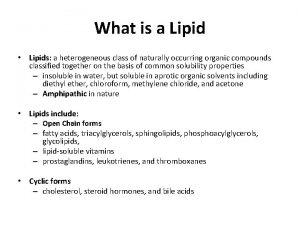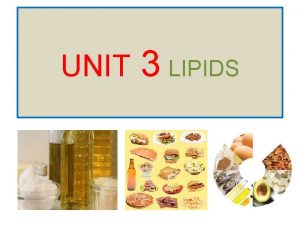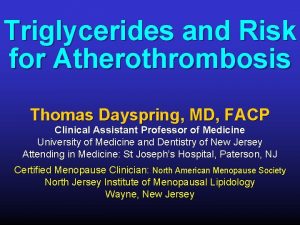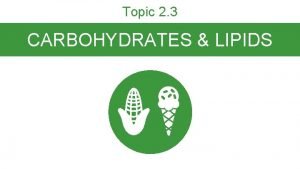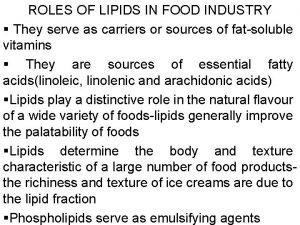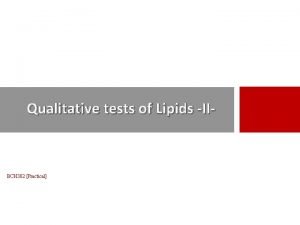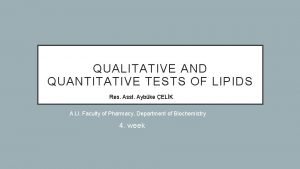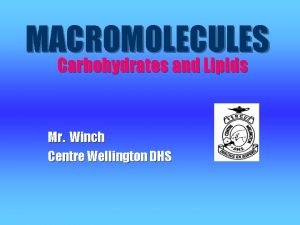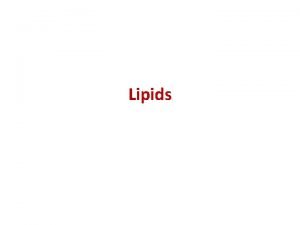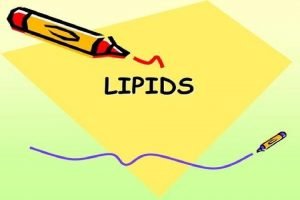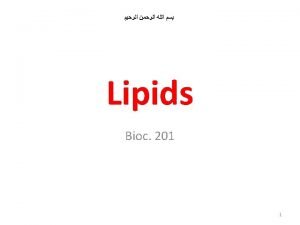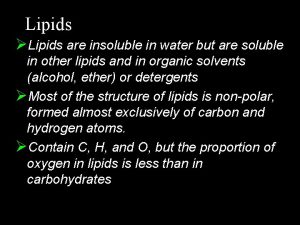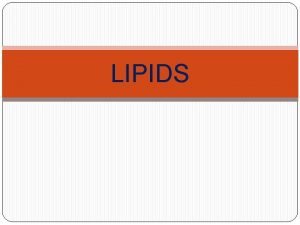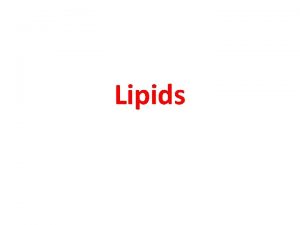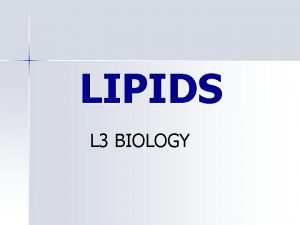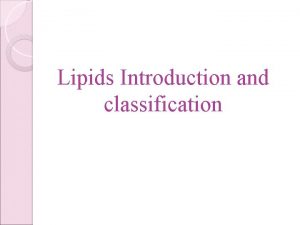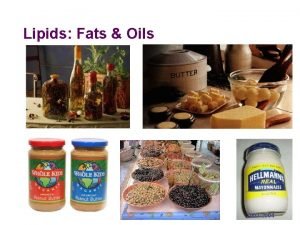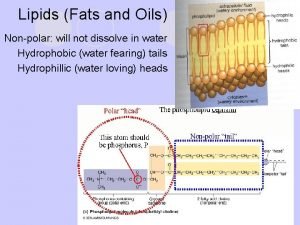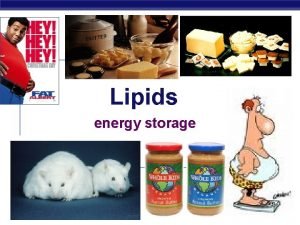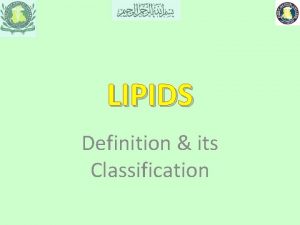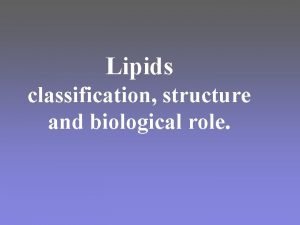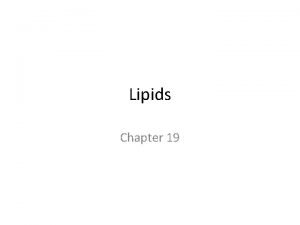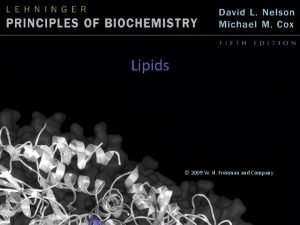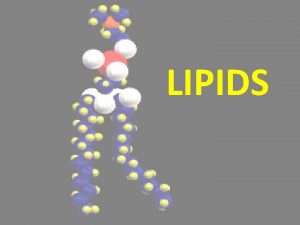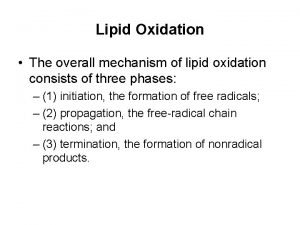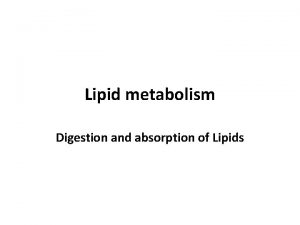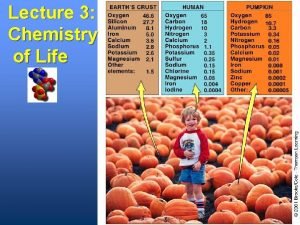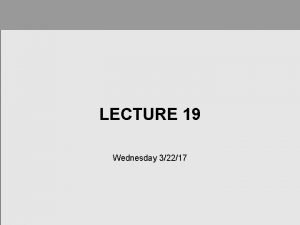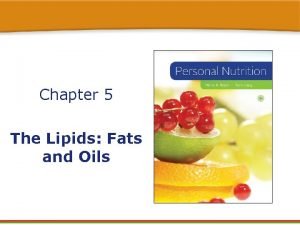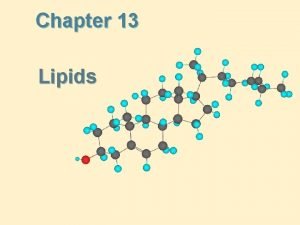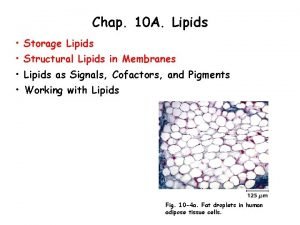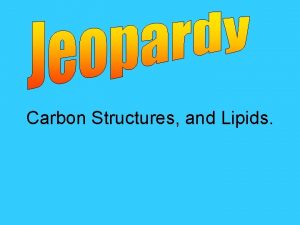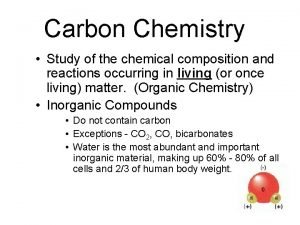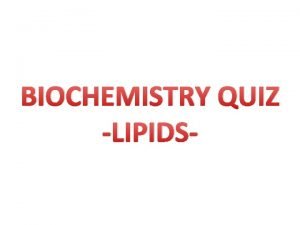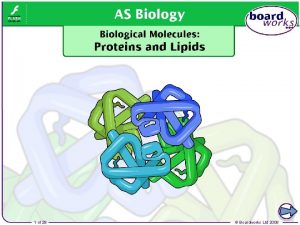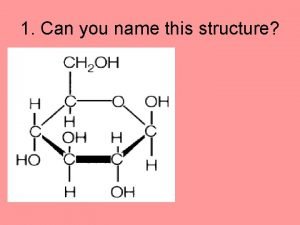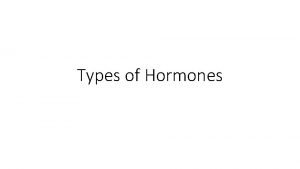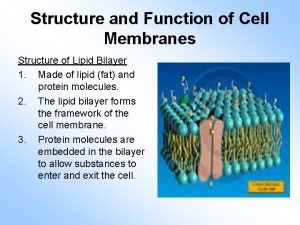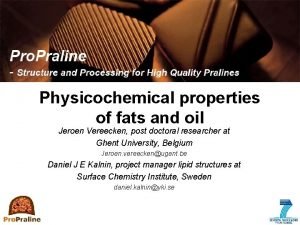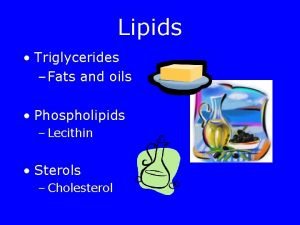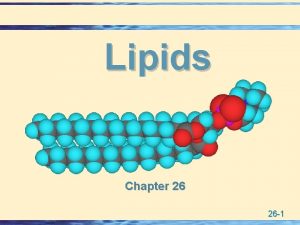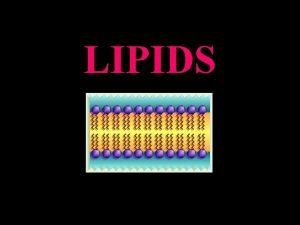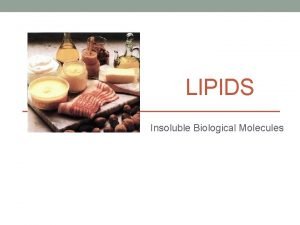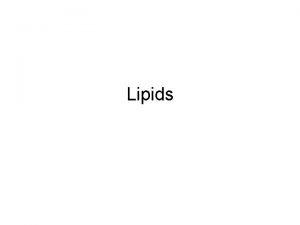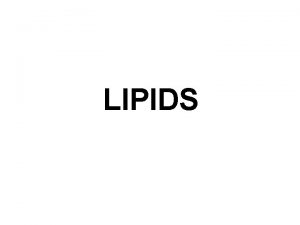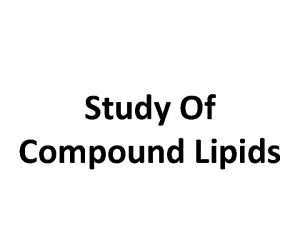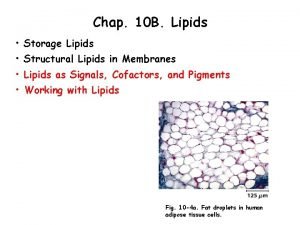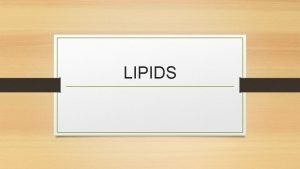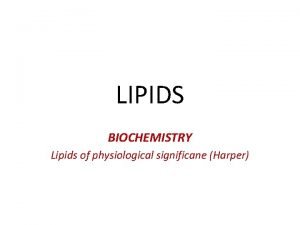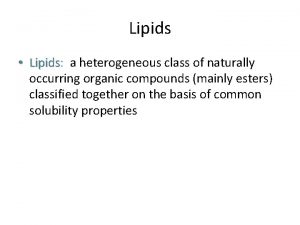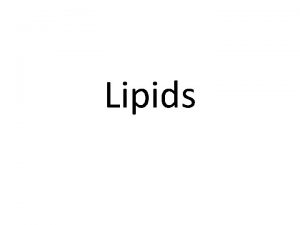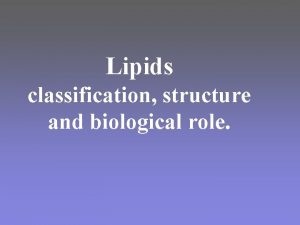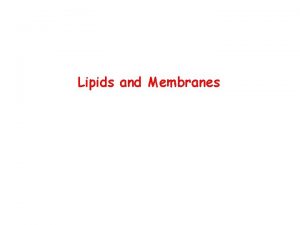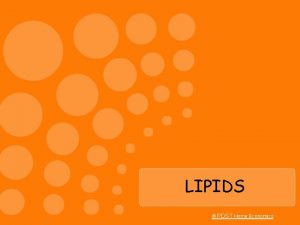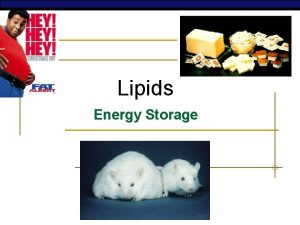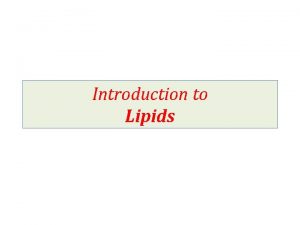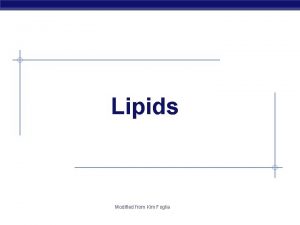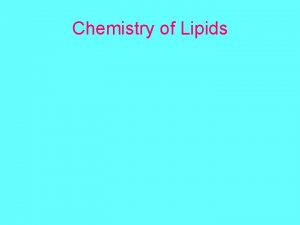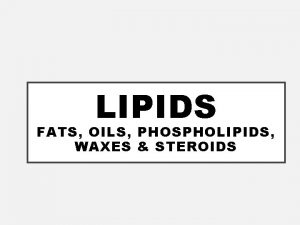Lipids Chapter 26 26 1 Lipids u Lipids
















































- Slides: 48

Lipids Chapter 26 26 -1

Lipids u Lipids: A heterogeneous class of naturally occurring organic compounds classified together on the basis of common solubility properties. • They are insoluble in water but soluble in aprotic organic solvents, including diethyl ether, methylene chloride, and acetone. u Lipids include: • triglycerides, phospholipids, prostaglandins, prostacyclins, and fat-soluble vitamins. • cholesterol, steroid hormones, and bile acids. 26 -2

Triglycerides u Triglyceride: An ester of glycerol with three fatty acids. Saponification 26 -3

Fatty Acids u Fatty acid: A carboxylic acid derived from hydrolysis of animal fats, vegetable oils, or membrane phospholipids. • Nearly all have an even number of carbon atoms, most between 12 and 20, in an unbranched chain. • The three most abundant are palmitic (16: 0), stearic (18: 0), and oleic acid (18: 1), where the first number is the number of carbons and the second is the number of double bonds in the hydrocarbon chain. • In most unsaturated fatty acids, the cis isomer predominates; the trans isomer is rare. • Unsaturated fatty acids have lower melting points than their saturated counterparts; the greater the degree of unsaturation, the lower the melting point. 26 -4

Fatty Acids u The most common fatty acids. Higher mp Lower mp 26 -5

Triglycerides u Physical properties depend on the fatty acid components. • Melting point increases as the number of carbons in its hydrocarbon chains increases and as the number of double bonds decreases. • Oils: Triglycerides rich in unsaturated fatty acids are generally liquid at room. • Fats: Triglycerides rich in saturated fatty acids are generally semisolids or solids at room temperature. 26 -6

Triglycerides • example: a triglyceride derived from one molecule each of palmitic acid, oleic acid, and stearic acid, the three most abundant fatty acids in the biological world. 26 -7

Triglycerides u The lower melting points of triglycerides rich in unsaturated fatty acids are related to differences in their three-dimensional shape. • Hydrocarbon chains of saturated fatty acids can lie parallel with strong dispersion forces between their chains; they pack into well-ordered, compact crystalline forms and melt above room temperature. • Because of the cis configuration of the double bonds in unsaturated fatty acids, their hydrocarbon chains have a less ordered structure and dispersion forces between them are weaker; these triglycerides have melting points below room temperature. 26 -8

Soaps and Detergents u Natural soaps are prepared by boiling lard or other animal fat with Na. OH, in a reaction called saponification (Latin, sapo, soap). 26 -9

Soaps and Detergents u Soaps clean by acting as emulsifying agents: • Their long hydrophobic hydrocarbon chains are insoluble in water and tend to cluster in such a way as to minimize their contact with water. • Their polar hydrophilic carboxylate groups, on the other hand, tend to remain in contact with the surrounding water molecules. • Driven by these two forces, soap molecules spontaneously cluster into micelles. 26 -10

Soaps and Detergents • A soap micelle: nonpolar (hydrophobic) hydrocarbon chains cluster in the inside and polar (hydrophilic) carboxylate groups lie on the surface. 26 -11

Soaps and Detergents • micelle: A spherical arrangement of organic molecules in water clustered so that their hydrophobic parts are buried inside the sphere and their hydrophilic parts are on the surface of the sphere and in contact with water. • when soap is mixed with water-insoluble grease, oil, and fats, the nonpolar parts of the soap micelles “dissolve” these nonpolar dirt molecules and they are carried away in the polar wash water. 26 -12

Soaps and Detergents u Soaps form water-insoluble salts when used in water containing Ca(II), Mg(II), and Fe(III) ions (hard water). water 26 -13

Synthetic Detergents u The design criteria for a good detergent are: • a long hydrocarbon tail of 12 to 20 carbons. • a polar head group that does not form insoluble salts with Ca(II), Mg(II), or Fe(III) ions. u The most widely used synthetic detergents are the linear alkylbenzenesulfonates (LAS). 26 -14

Synthetic Detergents u Also added to detergent preparations are: • foam stabilizers. • bleaches. • optical brighteners. 26 -15

Prostaglandins u Prostaglandins: A family of compounds that have the 20 -carbon skeleton of prostanoic acid. 26 -16

Prostaglandins, origin u Prostaglandins are not stored in tissues as such, but are synthesized from membrane-bound 20 carbon polyunsaturated fatty acids in response to specific physiological triggers. • One such polyunsaturated fatty acid is arachidonic acid (notice the all cis configurations). 26 -17

Prostaglandins, examples • Among the prostaglandins synthesized biochemically from arachidonic acid are: PGE 2 generated in macrophages of the liver and lungs triggers the earliest phase of fever following any infection 26 -18

Prostaglandins u Research on the involvement of PGs in reproductive physiology has produced several clinically useful derivatives. • (15 S)-15 -methyl-PGF 2 is used as a therapeutic abortifacient. 26 -19

Prostaglandins • The PGE 1 analog, misoprostol, is used to prevent the ulceration associated with the use of aspirin. 26 -20

Eicosanoids u The prostaglandins are members of an even larger family of compounds called eicosanoids, eicosanoids all of which contain 20 carbons and are derived from polyunsaturated fatty acids. 26 -21

Eicosanoids u Leukotrienes are found primarily in white blood cells. • One function is constriction of smooth muscles, especially those of the lungs. 26 -22

Steroids u Steroids: A group of plant and animal lipids that have this tetracyclic ring structure. u The features common to the ring system of most naturally occurring steroids are illustrated next. 26 -23

Steroids • The fusion of rings is trans and each atom or group at a ring junction is axial. • The pattern of atoms or groups along the ring junctions is nearly always trans-anti-trans. • The steroid system is nearly flat and quite rigid. • Most have axial methyl groups at C-10 and C-13. 26 -24

Cholesterol 26 -25

Androgens u Androgens - male sex hormones. 26 -26

Synthetic Anabolic Steroids • A way to increase the testosterone concentration is to use a prohormone, which the body converts to testosterone; for example “andro”. 26 -27

Available on the internet, dangerous u u Generic Name: methandrostenolone Danabol / Dianabol has always been one of the most popular anabolic steroids available. Danabol / Dianabol's popularity stems from it's almost immediate and very strong anabolic effects. 4 -5 tablets a day is enough to give almost anybody dramatic results. It is usually stacked with deca durabolin and testosterone enanthate. Along with strong anabolic effects comes the usual androgen side effects, users often report an overall sense of well being. Danabol / Dianabol is a strong anabolic androgenic product. It most often produced dramatic gains in size and strength. Danabol / Dianabol was also shown to increase endurance and glycogen retention. The down side is that this drug is responsible for a number of side effects. It is an alpha alkylated 17 compound, which is quite toxic to the liver. Average dosages for Danabol / Dianabol have been in the range of 15 mg to 30 mg a day oral or 50 mg to 100 mg a week by injection. Regarded by many athletes as being one of the most effective oral steroids ever produced. It was not known as the "Breakfast of Champions" for nothing. Danabol / Dianabol is still one of the most effective strength and size building oral steroids probably second only to Anadrol 50 but it is not as harsh on the system as Anadrol 50 is. 26 -28

Estrogens u Estrogens - female sex hormones. 26 -29

Synthetic Estrogens u Progesterone-like analogs are used in oral contraceptives. 26 -30

Glucorticoid Hormones • • Synthesized in the adrenal cortex. Regulate metabolism of carbohydrates. Decrease inflammation. Involved in the reaction to stress. 26 -31

Mineralocorticoid Hormones • Synthesized in the adrenal cortex. • Regulate blood pressure and volume by stimulating the kidneys to absorb Na+, Cl-, and HCO 3 -. 26 -32

Bile Acids u Synthesized in the liver, stored in the gallbladder, and secreted into the intestine where their function is emulsify dietary fats and aid in their absorption and digestion. 26 -33

Biosynthesis of Steroids u The building block from which all carbon atoms of steroids are derived is the two carbon acetyl group of acetyl-Co. A Stage 1: synthesis of isopentenyl pyrophosphate from three molecules of acetyl-Co. A. Stage 2: synthesis of cholesterol. Stage 3: conversion of cholesterol to other steroids. 26 -34

Vitamin E 26 -35

Phospholipids u Phospholipids are the second most abundant group of naturally occurring lipids. • They are found almost exclusively in plant and animal membranes, which typically consist of 40% -50% phospholipids and 50% - 60% proteins. • The most abundant phospholipids are esters of phosphatidic acid (glycerol esterified with two molecules of fatty acid and one of phosphoric acid). • The three most abundant fatty acids in phosphatidic acids are palmitic acid (16: 0), stearic acid (18: 0), and oleic acid (18: 1). 26 -36

Phosphatidic acids, an example u. A phosphatidic acid • Further esterification with a low-molecular weight alcohol gives a phospholipid. 26 -37

Phospholipids • Among the most common of these low-molecularweight alcohols are: 26 -38

Phospholipids, an example u. A lecithin In aqueous solution, phospholipids spontaneously form into a lipid bilayer, with a back-to-back arrangement of lipid monolayers. 26 -39

Biological Membranes u Fluid mosaic model: A biological membrane consists of a phospholipid bilayer with proteins, carbohydrates, and other lipids embedded on the surface and in the bilayer. • fluid: fluid Signifies that the protein components of membranes “float” in the bilayer and can move freely along the plane of the membrane. • mosaic: mosaic Signifies that the various components of the membrane exist side by side, as discrete units rather than combining to form new molecules and ions. 26 -40

Biological Membranes • Fluid-mosaic model of a biological membrane showing the lipid bilayer and membrane proteins on the inner and outer surfaces of the membrane and penetrating the thickness of the membrane. 26 -41

Fat-Soluble Vitamins u Vitamins are divided into two broad classes on the basis of their solubility: • Those that are fat soluble, and hence classified as lipids. • Those that are water soluble. u The fat-soluble vitamins include A, D, E, and K. 26 -42

Vitamin A • Occurs only in the animal world. • Found in the plant world in the form of a provitamin in a group of pigments called carotenes. 26 -43

Vitamin A u The best understood role of Vitamin A is its participation in the visual cycle in rod cells. • the active molecule is retinal (vitamin A aldehyde), which forms an imine with an -NH 2 group of the protein opsin to form the visual pigment called rhodopsin. • the primary chemical event of vision in rod cells is absorption of light by rhodopsin followed by isomerization of the 11 -cis double bond to the 11 -trans configuration. 26 -44

Vitamin A and the Chemistry of Vision 26 -45

Vitamin D u. A group of structurally related compounds that play a role in the regulation of calcium and phosphorus metabolism. • The most abundant form in the circulatory system is vitamin D 3. 26 -47

Vitamin E u Vitamin E is a group of compounds of similar structure, the most active of which is tocopherol. • In the body, vitamin E functions as an antioxidant; it traps peroxy radicals of the type HOO • and ROO • formed as a result of oxidation by O 2 of unsaturated hydrocarbon chains in membrane phospholipids. 26 -48

Vitamin K u The name of this vitamin comes from the German word Koagulation, signifying its important role in the blood-clotting process. 26 -49
 Chapter 10 lipids nature's flavor enhancers answers
Chapter 10 lipids nature's flavor enhancers answers Heterogeneous lipids
Heterogeneous lipids What are lipids
What are lipids Test for fat
Test for fat Neutral fat
Neutral fat Tom dayspring lipids
Tom dayspring lipids Carbohydrate vs lipid structure
Carbohydrate vs lipid structure Application of lipids in food industry
Application of lipids in food industry Qualitative tests for lipids
Qualitative tests for lipids Qualitative and quantitative test for lipids
Qualitative and quantitative test for lipids Food source of nucleic acids
Food source of nucleic acids Lipids made up of rigid carbon rings
Lipids made up of rigid carbon rings Nonpolar lipids
Nonpolar lipids Lipids are heterogeneous group of compounds
Lipids are heterogeneous group of compounds Is lipid long term energy
Is lipid long term energy Saponification of triglycerides
Saponification of triglycerides Are lipids insoluble in water
Are lipids insoluble in water Triacylglycerols
Triacylglycerols Function of lipids
Function of lipids Facts about lipids biology
Facts about lipids biology Facts of lipids
Facts of lipids Are lipids non polar
Are lipids non polar Examples of lipids
Examples of lipids Are lipids hydrophobic
Are lipids hydrophobic Are lipids energy storage
Are lipids energy storage Examples of lipids
Examples of lipids Function of lipids
Function of lipids Are lipids energy storage
Are lipids energy storage W.h. freeman & company
W.h. freeman & company Lipid
Lipid Apa itu tbhq
Apa itu tbhq Digestion and absorption of lipids
Digestion and absorption of lipids Lipids made up of rigid carbon rings
Lipids made up of rigid carbon rings Wednesday two of the key
Wednesday two of the key Rancidity chemical reaction
Rancidity chemical reaction Saturated vs unsaturated fatty acids
Saturated vs unsaturated fatty acids Lipids made up of rigid carbon rings
Lipids made up of rigid carbon rings Complex lipids
Complex lipids Storage lipid structure
Storage lipid structure What elements do lipids contain
What elements do lipids contain Monomers of lipids
Monomers of lipids Lipids quiz biochemistry
Lipids quiz biochemistry Examples of lipids
Examples of lipids Emulsion test for lipids
Emulsion test for lipids Monomer in lipids
Monomer in lipids Steroid hormones include
Steroid hormones include What is the function of a cell membrane
What is the function of a cell membrane Van luin ice cream
Van luin ice cream Benefits of lipids
Benefits of lipids

